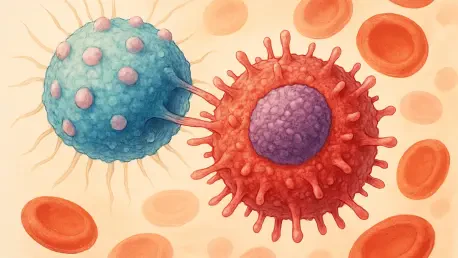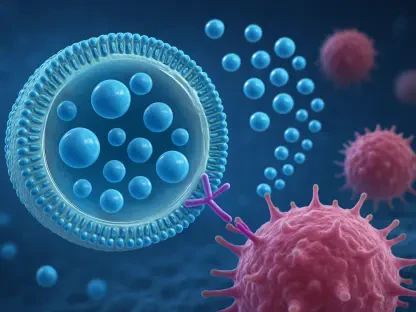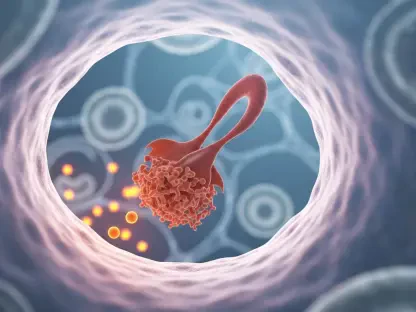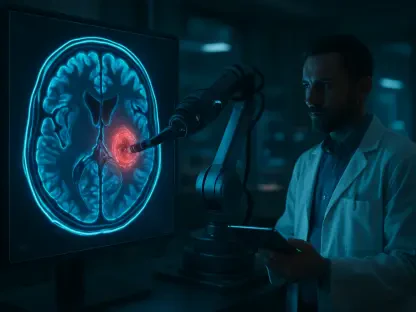For over 20 years, the medical community has been exploring innovative ways to combat acute myeloid leukemia (AML), a devastating blood cancer notorious for its aggressive progression and high relapse rates despite treatments like chemotherapy and stem cell transplantation. Among the most promising advancements is natural killer (NK) cell therapy, an immunotherapy that taps into the body’s innate defenses to target malignant cells. This approach has captured significant attention through numerous clinical trials, revealing both remarkable potential and persistent obstacles. A comprehensive review published recently in a leading cancer journal provides an in-depth look at these efforts, analyzing data spanning two decades of research. This article examines the key achievements in NK cell-based treatments for AML, from their biological strengths to clinical outcomes, while also addressing the challenges that remain in translating this therapy into a widely accessible option for patients battling this relentless disease.
Harnessing the Immune System’s Hidden Weapon
The foundation of NK cell therapy lies in the unique capabilities of these immune system warriors, which are naturally equipped to identify and eliminate cancerous cells without the need for prior exposure or specific antigen recognition. This inherent trait makes them particularly suited for tackling AML, a disease characterized by diverse and often resistant cancer cell populations. Unlike other immune therapies that rely on tailored responses, NK cells operate through a sophisticated balance of activating and inhibitory signals, allowing them to detect stressed or malignant cells with precision. Research over the past two decades has underscored their potential to address gaps left by conventional treatments, offering hope for reducing the high relapse rates that plague AML patients. Their ability to act swiftly without customization positions them as a versatile tool in the oncological arsenal, sparking optimism for better outcomes in a field where options remain limited for many.
Another critical aspect of NK cell therapy development has been the focus on sourcing and preparing these cells for clinical use, with peripheral blood emerging as the predominant source in over 80% of trials due to its accessibility and proven efficacy. Advanced purification methods, such as those employing CliniMACS technology, ensure that NK cell populations are isolated with high purity by removing contaminating immune components. Trials have explored diverse activation strategies, ranging from short-term boosts lasting less than a day to extended expansion protocols spanning over a week. Each method influences the cells’ potency and durability in unique ways, shaping their ability to fight AML effectively. The systematic analysis of these approaches highlights a trend toward refining preparation techniques, though variations persist, reflecting the ongoing quest to optimize NK cell performance for therapeutic success.
Measuring Success in Clinical Settings
Clinical trials spanning the last 20 years have delivered compelling evidence of NK cell therapy’s impact on AML, particularly in achieving meaningful remission and survival rates. In non-transplant settings, a complete remission rate of 37.1% has been reported, indicating that a significant number of patients experienced full disease regression, at least temporarily. Even more striking is the event-free survival rate of 71.3%, suggesting that many patients enjoyed prolonged periods without disease progression. In the context of post-stem cell transplantation, overall survival reached 39.5%, demonstrating a valuable role in preventing relapse—a major hurdle in AML management. These figures, drawn from extensive trial data, point to the therapy’s potential to alter treatment paradigms, especially for those with limited options, while also highlighting areas where further improvements are needed to sustain long-term benefits.
Equally important to the raw numbers is the deeper understanding of how NK cells interact with AML at a mechanistic level, offering insights into why these outcomes are possible. Their broad-spectrum targeting capability, which doesn’t rely on specific markers, allows them to confront the heterogeneity of AML cells effectively. Research has increasingly focused on optimizing conditions for NK cell expansion and activation to enhance their cancer-killing power. Studies are also delving into how these cells navigate the challenging tumor microenvironment, which can suppress immune activity. This exploration is crucial for ensuring that NK cells maintain their effectiveness over time, providing a foundation for refining therapeutic protocols. Such mechanistic insights are vital for pushing the boundaries of what this therapy can achieve, paving the way for more tailored and durable interventions in clinical practice.
Navigating the Roadblocks to Wider Adoption
Despite the encouraging progress, NK cell therapy faces significant barriers that hinder its transition from experimental to standard care for AML patients. One major issue is the limited persistence of NK cells in the body after administration, which often curtails their long-term effectiveness against cancer. Additionally, the immunosuppressive nature of the tumor microenvironment in AML can dampen their activity, reducing their ability to attack malignant cells. Compounding these biological challenges are practical concerns, such as the lack of standardized manufacturing processes across trials, which makes it difficult to compare results or ensure consistency. Scalability remains another hurdle, as producing NK cell products on a large scale for widespread use is fraught with logistical and technical difficulties. Addressing these obstacles is essential for unlocking the full potential of this promising therapy.
Another dimension of the challenge lies in integrating NK cell therapy with existing treatment modalities to maximize its impact on AML outcomes. The systematic review of past trials suggests that combining this approach with interventions like stem cell transplantation or chemotherapy could create synergistic effects, amplifying the overall attack on cancer cells. While not extensively covered in the analyzed studies, emerging concepts such as genetically engineered NK cells point to innovative directions for future research. These integrative strategies hold the promise of a multi-faceted treatment framework, potentially overcoming some of the standalone limitations of NK cell therapy. Exploring such combinations could be a game-changer, offering new hope for patients by addressing the disease from multiple angles and enhancing the durability of therapeutic responses.
Safety as a Cornerstone of NK Therapy
A standout feature of NK cell therapy that has emerged over two decades of research is its impressive safety profile, setting it apart from other immunotherapies that often carry significant risks. The rarity of severe adverse events and manageable toxicity levels make it a viable option for both frontline and salvage treatments, particularly for AML patients who may not tolerate intensive regimens due to age or other health conditions. Notably, the low incidence of graft-versus-host disease—a life-threatening complication often associated with allogeneic stem cell transplants—further enhances its appeal. This safety advantage, consistently noted across numerous trials, positions NK cell therapy as a gentler yet effective alternative, broadening its potential application in diverse patient populations and treatment settings.
Building on this safety foundation, the therapy’s compatibility with various clinical contexts underscores its versatility as a tool against AML. Whether used as a standalone intervention or as a supportive measure following transplantation, NK cells have demonstrated an ability to improve outcomes without adding substantial risk to patients. This adaptability is particularly significant given the complex needs of AML patients, many of whom face recurring disease or treatment resistance. The favorable tolerability profile also opens doors for repeated administrations or combination approaches without overwhelming the patient’s system. As research progresses, leveraging this safety aspect could be key to designing protocols that balance efficacy with minimal harm, ensuring that more individuals can benefit from this innovative treatment without undue burden.
Charting the Path Forward for AML Treatment
Reflecting on two decades of exploration, the journey of NK cell therapy for AML reveals a landscape filled with both groundbreaking achievements and formidable challenges that have shaped its evolution. The therapy has carved out a niche by demonstrating significant remission and survival rates, alongside a safety profile that stands out in the realm of cancer treatments. Yet, hurdles like limited cell persistence and inconsistent production methods underscore the gaps that need bridging. These insights, drawn from extensive clinical trial data, paint a picture of a field on the cusp of transformation, driven by a commitment to harnessing immunity against a relentless disease.
Looking ahead, the focus must shift to actionable steps that build on past learnings, such as conducting larger, controlled trials to validate efficacy and refine dosing strategies for NK cell therapy. Standardizing manufacturing processes will be crucial to ensure consistency and scalability, making this treatment accessible to a broader patient base. Additionally, exploring synergies with emerging technologies and other therapies could unlock new avenues for combating AML comprehensively. The foundation laid over the years offers a springboard for innovation, urging the medical community to push boundaries and redefine possibilities for those affected by this challenging cancer.









